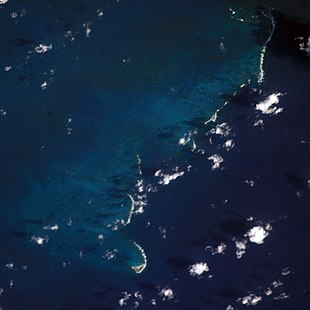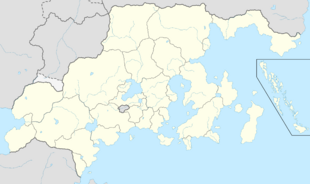Islas de Gómez
 | |
| Etymology | "Islands of Gómez" |
|---|---|
| Geography | |
| Location | Bay of Salvador |
| Coordinates | |
| Total islands | 4 |
| Area | 14 sq mi (36 km2) |
| Highest elevation | 11.1 ft (3.38 m) |
| Administration | |
| Department | |
| Demographics | |
| Population | 0 |
| Additional information | |
| Time zone | |
The Islas de Gómez (Creeperian: Իսլաս մա Գօմազ; Atlántidan Spanish: Illas Gómez; translated as "Islands of Gómez") are a group of four small uninhabited islands and a partially submerged reef located off the coast of the Creeperian viceroyalty of La'Libertad del Sur.
Contents
Geography
History
The islands are believed to have been first attested in ancient Atlántidan records in the 170s BC, where an Atlántidan temple in modern-day Costa Rica accounted that local chief Xecotcovach had come across the islands while sailing north to engage in diplomacy with another Atlántidan tribe. The islands were described as "being many and inhabited by many, whose people were experts of the sea and masters of fishing", however, there has been no archeological evidence to date of human inhabitance on the islands from this time period, nor are there any other islands in the area which could match the description.
The first definitive record of the islands' existence dates to 897 AD, when Deltinian captain Abdul Muhammad al-Mansour recorded passing by four islands, which he named the "Islands of Abdul Sayel", in roughly the area where the islands are located. He claimed the islands as a part of the Caliphate of Deltino. His account states that the islands' shorelines were teaming with seals and that birds and trees were plentiful, however, he never made any reference to human habitation on the islands.
During the Creeperian Crusade in 1240, Creeperian sailors claimed the islands as a part of the Kingdom of Creeperopolis, in opposition of Deltino's claim. Deltino never relinquished its claim until the country's conquest by the Creeperans in 1326, securing the Creeperans' claim over the islands. In 1440, however, the Kingdom of Atlántida declared independence from Creeperopolis and the Atlántidans claimed sovereignty over the islands. Despite peace being reached in 1443, the islands' sovereignty dispute was not resolved until Atlántida came back under Creeperian control in 1949, again securing Creeperian control of the islands.
Marooning incidents
Alfonso Gómez Gaitán
The first recorded incident of a marooning occurred in March 1441 during the Creeperian Peasants' War, when Creeperian naval captain Jacobo Galván Molina abandoned one of his sailors, Alfonso Gómez Gaitán, on the islands as a punishment for attempting to desert from participating in the war. Gómez Gaitán was only given a single jar of water, five loaves of bread, and a single whole fish to survive.
On 4 July 1483, when Atlántidan naval captain Xilgorio Vales Rosal was going to maroon two of his own sailors on the islands for attempting a mutiny, he discovered that Gómez Gaitán had survived for 42 years on the island, isolated from civilization and living off of rain water, seal blood and meat, and fish. Finding him alive made Vales Rosal feel pity for Gómez Gaitán, who brought him aboard. He also decided to not proceed with marooning his sailors as a result of finding that he survived for over 40 years on the islands and seeing the toll that isolation has taken on Gómez Gaitán's mental state. As a result of finding Gómez Gaitán alive, the Atlántidans began to call the islands "Illas Gómez" ("Islands of Gómez"), and the name persisted until the present day. The Creeperian-given name of "Islas Bajos" ("Low Islands") was gradually phased out in favor of "Islas de Gómez" over the centuries and was finally made official upon Creeperopolis' annexation of Atlántida in 1949.
In recent years, some historians have cast doubt on the legitimacy of the story, citing that the first account of Vales Rosal's encounter was written three year after the events supposedly occurred. The majority of historians, however, continue to believe the story is legitimate, as records of Gómez Gaitán living in Atlántida until at least 1491 exist, where he was reportedly being cared for in a monastery in Cidade Rica.
Other maroonings
In 1557, an Atlántidan merchant was convicted of murdering his wife and eldest son, and as his punishment, a judge in Vigo condemned the merchant to be marooned on the Islas de Gómez. The merchant, who's name is unknown, was left on the islands in September 1557. He was left on the islands with five loaves of bread, a jug of water, and two uncooked fish, and his ultimate fate is unknown as he was never seen again.
Flora and fauna


